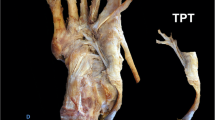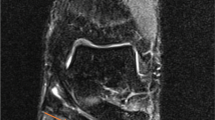Abstract
Background
Medial aspect of foot is unexplored due to its complex anatomy. Masterknot of Henry is an important landmark in this region, which plays a key role during tendon transfer procedures especially in those involving the flexor hallucis longus and flexor digitorum longus. We aim to determine the exact anatomical location of masterknot of Henry with respect to the bony prominences of the medial aspect of the foot and compare these measurements to the length of the foot.
Methods
Twenty cadaveric below-knee specimens were dissected. Structures on the medial side of the foot were exposed. Distance of the masterknot of Henry from surrounding bony landmarks was measured. Depth of the masterknot from skin of the plantar aspect was also measured. Means of all parameters were calculated. Relation between measurements and the foot length was determined using correlation and regression analysis. P value of less than 0.05 was considered significant.
Results
Distance of masterknot of Henry from navicular tuberosity was found to be fairly constant of 19.965 mm. Foot length was found to be correlating with the distance between masterknot of Henry and medial malleolus, navicular tuberosity and its depth from the skin.
Conclusions
Navicular tuberosity can be considered an important surface landmark for the location of masterknot of Henry. Correlation of length of the feet with various measurements helps to find the masterknot considering the foot length to be an important variable. Good knowledge of surface anatomy leads to shorter operating time and less morbidity during procedures involving the flexor hallucis longus and flexor digitorum longus.




Similar content being viewed by others
References
Lehnert, B., Nyska, M., Ip, W., Huynh, E., & Palmanovich, E. (2017). Flexor Digitorum Longus (FDL) or Flexor Hallucis Longus (FHL) harvesting: technical tip and case studies. Foot & Ankle International, 38(11), 1267–1270.
Mao, H., Shi, Z., Wapner, K. L., et al. (2015). Anatomical study for flexor hallucis longus tendon transfer in treatment of Achilles tendinopathy. Surgical and Radiologic Anatomy, 37, 639–647.
Amlang, M., Rosenow, M. C., Friedrich, A., Zwipp, H., & Rammelt, S. (2012). Direct plantar approach to Henry’s knot for flexor hallucis longus transfer. Foot and Ankle International, 33(1), 7–13. https://doi.org/10.3113/FAI.2012.0007. PMID: 22381230.
Panchbhavi, V. K. (2014). Percutaneous techniques for tendon transfers in the foot and ankle. Foot and Ankle Clinics, 19(1), 113–122. https://doi.org/10.1016/j.fcl.2013.10.008
Beger, O., Elvan, Ö., Keskinbora, M., Ün, B., Uzmansel, D., & Kurtoğlu, Z. (2018). Anatomy of Master Knot of Henry: A morphometric study on cadavers. Acta Orthopaedica et Traumatologica Turcica, 52(2), 134–142. https://doi.org/10.1016/j.aott.2018.01.001
Park, K. R., Park, W. J., Lee, S. W., Kim, H., Lee, H., & Lee, J. H. (2022). A simple method to locate the master knot of henry using the correlation between the flexor tendon length parameter and the foot length. International Journal of Environmental Research and Public Health, 19(4), 2281. https://doi.org/10.3390/ijerph19042281
Lui, T. H. (2015). Endoscopic-Assisted Flexor Hallucis Longus Transfer: Harvest of the Tendon at Zone 2 or Zone 3. Arthroscopy Techniques, 4(6), e811–e814. https://doi.org/10.1016/j.eats.2015.08.008
Author information
Authors and Affiliations
Corresponding author
Ethics declarations
Conflict of Interest
The authors declare that they have no conflict of interest.
Ethical standard statement
This article does not contain any studies with human or animal subjects performed by the any of the authors.
Informed consent
For this type of study informed consent is not required.
Additional information
Publisher's Note
Springer Nature remains neutral with regard to jurisdictional claims in published maps and institutional affiliations.
Rights and permissions
Springer Nature or its licensor (e.g. a society or other partner) holds exclusive rights to this article under a publishing agreement with the author(s) or other rightsholder(s); author self-archiving of the accepted manuscript version of this article is solely governed by the terms of such publishing agreement and applicable law.
About this article
Cite this article
Galagali, D.A., Bhatia, A., Ajoy, S.M. et al. Navicular Tuberosity: A Surface Landmark for the Masterknot of Henry. JOIO 57, 1100–1104 (2023). https://doi.org/10.1007/s43465-023-00883-w
Received:
Accepted:
Published:
Issue Date:
DOI: https://doi.org/10.1007/s43465-023-00883-w




